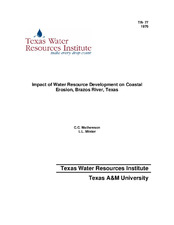| dc.description.abstract | Major dam and reservoir development within the Brazos River Basin is correlative with a significant decrease in the suspended sediment load of the river and with increased coastal erosion rates near the delta. A hydrologic analysis of the river discharge, by use of cumulative frequency curves, shows that discharge control by dam regulation has reduced the frequency of high discharges, thus smoothing out the river hydrograph and reducing the amount of sediment the river is able to carry and deliver to the coastal zone. In addition, the reservoirs are presently trapping about 76¡% of all sand produced within the basin. An analysis of bed load samples taken downstream of the dams indicates that the sand sizes necessary for beach nourishment are not being transported through the lower reaches of the river. The amount of sand denied access to the coastal zone through the loss of the river's transporting ability and reservoir entrapment has been determined, and is shown to be enough to account for the entire increase in the coastal erosion rates in the study area since at least 1937. Future sand losses brought about by the construction of new reservoirs downstream of those presently on the Brazos River, or one of its major tributaries, can be predicted by the decrease in the effective drainage basin area. | en |


